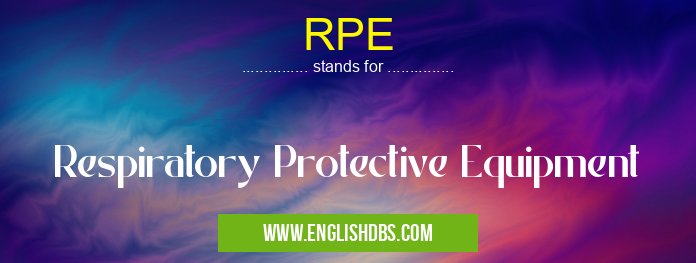What does RPE mean in HOSPITALS
Respiratory Protective Equipment (RPE) is used to protect the wearer from inhalation of hazardous substances in the air. RPE should be worn whenever respiratory protection is needed due to a hazard of an airborne nature. It may also be referred to as respirators, breathing apparatus, or air-purifying respirators (APRs). RPE comes in different forms and are designed to protect against different hazards such as dusts, fumes, gases, vapours and mists.

RPE meaning in Hospitals in Medical
RPE mostly used in an acronym Hospitals in Category Medical that means Respiratory Protective Equipment
Shorthand: RPE,
Full Form: Respiratory Protective Equipment
For more information of "Respiratory Protective Equipment", see the section below.
Types of RPE
There are several types of RPE that can provide varying levels of protection depending on the hazard present. These include gas masks (full face/half face), powered air purifying respirators (PAPRs), self-contained breathing apparatus (SCBAs) and disposable respirators (filtering facepieces). Gas masks offer a higher level of protection than other types of RPE but are not suitable for all environments, so it is important to choose the correct type for the specific hazard present. PAPRs are battery powered devices that use filters or cartridges to remove hazardous particles from inhaled air, while SCBAs are typically used in hazardous environments where oxygen levels may be too low for normal breathing. Disposable respirators provide basic protection against dusts and mists and should only be used where there is no risk of exposure to other types of airborne contaminants.
Advantages & Disadvantages of RPE
RPE offers a number of advantages over other forms of respiratory protection. It provides effective protection against hazardous particles in the air when worn correctly and properly maintained. It is also relatively affordable compared to other forms of respiratory protection such as PAPRs and SCBAs. However, there are some drawbacks associated with using RPE including cost, comfort and fit issues, as well as health concerns due to improper use or maintenance. Additionally, when not properly used or maintained there is an increased risk for leakage which can lead to exposure for the wearer.
Essential Questions and Answers on Respiratory Protective Equipment in "MEDICAL»HOSP"
What types of RPE are commonly used?
There are three main types of RPE commonly used in industrial settings. These include air-purifying respirators, powered air-purifying respirators (PAPRs), and self-contained breathing apparatus (SCBAs). Air-purifying respirators filter out particles from the air, while PAPR's use a motor to draw air through the filter. SCBAs provide independent oxygen sources that are not dependent on external air sources.
How should I choose an appropriate RPE?
It is important to assess the type of work being done, as well as any potential hazards present in the work environment when choosing an appropriate RPE. Hazards will dictate what type and level of protection is necessary for safe working conditions. A professional risk assessment must be conducted to determine the correct type and level of protection for each worker.
What factors should I consider when selecting RPE?
When choosing an appropriate RPE, several factors should be taken into account including fit, comfort, protection against hazards, ease of use, and compatibility with other pieces of personal protective equipment (PPE). For instance, certain filters may not provide adequate protection against certain substances depending on their chemical makeup. It is also important to ensure that the selected PPE fits properly and does not interfere with other required tasks or surface contact activities.
What kind of training do I need to use RPE correctly?
Proper training is essential to ensure that RPE is used safely and correctly. Training should cover topics such as proper selection & fitting procedures; correct donning/doffing processes; storage & cleaning practices; pre-use inspection; and limitations & restrictions associated with different types of product performance standards (e.g., diffusion vs absorption). Additionally, it is important that workers understand how different pieces of PPE interact with one another when used together so they can effectively reduce their exposure to hazardous materials.
Is it possible for my face shape or facial hair to impact the effectiveness of my RPE?
Yes, facial features such as facial hair can make a difference in how effective certain types of respirators are in protecting your health from workplace hazards because they can interfere with the seal formed between your skin and respirator facepiece resulting in poor levels of airborne particle filtration or exposure levels higher than desired. Therefore it’s important that workers who use tight fitting facepieces take special care when selecting RPE that best fits their individual faces so that they can get optimal safety performance out of them.
Are there any maintenance requirements for my RPE?
Most types of Respiratory Protective Equipment require regular maintenance and cleaning procedures along with pre/post use inspections prior to being put back into service after usage or storage. Some basic guidelines include changing filters/cartridges according to manufacturer specifications; cleaning surfaces regularly; inspecting parts such as straps or valve components annually; storing away clean parts separately from contaminated parts; disposal procedures if/when needed; etc
Are there certification standards available related to respiratory protective equipment?
Yes ,there are various international classification standards for respiratory protective equipment which determine which categories products fall within based on performance rating tests conducted under specific test conditions . This helps manufacturers and buyers alike understand which products meet certain criteria at minimum requirement levels.
Final Words:
Overall, Respiratory Protective Equipment (RPE) provides effective protection against airborne hazards when worn correctly and properly maintained. However, cost, comfort and fit issues need to be considered before making a decision about which type of RPE is most appropriate for the situation at hand. In addition proper maintenance is essential for ensuring that there is no leakage which could potentially put the wearer at risk for exposure.
